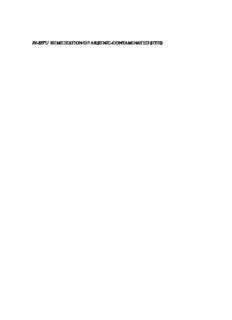
In-situ remediation of arsenic-contaminated sites PDF
Preview In-situ remediation of arsenic-contaminated sites
IN-SITU REMEDIATIONOFARSENIC-CONTAMINATEDSITES Arsenic in the Environment Series Editors Jochen Bundschuh UniversityofSouthernQueensland(USQ),Toowoomba,Australia RoyalInstituteofTechnology(KTH),Stockholm,Sweden Prosun Bhattacharya KTH-InternationalGroundwaterArsenicResearchGroup,DepartmentofLand andWaterResourcesEngineering,RoyalInstituteofTechnology(KTH), Stockholm,Sweden ISSN:1876-6218 Volume 6 Coverphoto Upperphoto:TheComarcaLaguneraisoneofthemostcontaminatedregionswheretheaquifers areseriouslycontaminatedwitharsenicinMexico.Continuousdrawdownsduetogroundwater miningmainlyforirrigationpurposesresultingeochemicalreactionwhichreleasesarsenicinto thegroundwater. Lower photo: Photoremediation of arsenic-contaminated groundwater using arsenic- hyperaccumulatorPterisvittata(Chinesebrakefern)inFlorida,USA. In-Situ Remediation of Arsenic-Contaminated Sites Editors JochenBundschuh UniversityofSouthernQueensland,FacultyofHealth,EngineeringandSciences& NationalCentreforEngineeringinAgriculture,Toowoomba,Queensland,Australia RoyalInstituteofTechnology(KTH),Stockholm,Sweden HartmutM.Holländer UniversityofManitoba,DepartmentofCivilEngineering,Manitoba,Canada LenaQiyingMa StateKeyLaboratoryofPollutionControlandResourceReuse, SchooloftheEnvironment,NanjingUniversity,JiangsuChinaand SoilandWaterScienceDepartment,UniversityofFlorida,Gainesville,USA Co-publishedbyIWAPublishing AllianceHouse,12CaxtonStreet,LondonSW1H0QS,UK Tel:+44(0)2076545500,Fax:+44(0)2076545555 [email protected] www.iwapublishing.com ISBN13:9781780406343 CRCPress/BalkemaisanimprintoftheTaylor&FrancisGroup,aninformabusiness ©2015Taylor&FrancisGroup,London,UK TypesetbyMPSLimited,Chennai,India PrintedandBoundinTheNetherlandsbyPrintSupport4U,Meppel Allrightsreserved.Nopartofthispublicationortheinformationcontainedhereinmaybe reproduced,storedinaretrievalsystem,ortransmittedinanyformorbyanymeans,electronic, mechanical,byphotocopying,recordingorotherwise,withoutwrittenpriorpermissionfrom thepublishers. Althoughallcareistakentoensureintegrityandthequalityofthispublicationandthe informationherein,noresponsibilityisassumedbythepublishersnortheauthorforany damagetothepropertyorpersonsasaresultofoperationoruseofthispublicationand/or theinformationcontainedherein. Publishedby: CRCPress/Balkema P.O.Box11320,2301EHLeiden,TheNetherlands e-mail:[email protected] www.crcpress.com–www.taylorandfrancis.com LibraryofCongressCataloging-in-PublicationData In-situremediationofarsenic-contaminatedsites/editors,JochenBundschuh, UniversityofSouthernQueensland,FacultyofHealth,EngineeringandSciences& NationalCentreforEngineeringinAgriculture,Toowoomba,Queensland, AustraliaRoyalInstituteofTechnology(KTH),Stockholm,Sweden,HartmutM. Holländer,UniversityofManitoba,DepartmentofCivilEngineering,Manitoba, Canada,LenaQiyingMa,StateKeyLaboratoryofPollutionControlandResourceReuse, SchooloftheEnvironment,NanjingUniversity,JiangsuChina[and]Departmentof SoilandWaterScience,UniversityofFlorida,Gainesville,USA. pagescm.—(Arsenicintheenvironment,ISSN1876-6218;volume6) Includesbibliographicalreferencesandindex. ISBN978-0-415-62085-7(hardback)— ISBN978-0-203-12017-0(ebookPDF) 1. Groundwater—Purification—Arsenicremoval. 2. Soilremediation. 3. Arsenic wastes—Environmentalaspects. 4. Insituremediation. I. Bundschuh,Jochen, editor. II. Holländer,HartmutM.,editor. III. Ma,LenaQiying,editor. TD427.A77I54 2014 628.1’6836—dc23 2014020023 ISBN:978-0-415-62085-7(Hardback) ISBN:978-0-203-12017-0(eBookPDF) About the book series Althougharsenichasbeenknownasa‘silenttoxin’sinceancienttimes,andthecontamination ofdrinkingwaterresourcesbygeogenicarsenicwasdescribedindifferentlocationsaroundthe world long ago — e.g. inArgentina in 1917 — it was only two decades ago that it received overwhelmingworldwidepublicattention.Asaconsequenceofthebiggestarseniccalamityin theworld,whichwasdetectedmorethantwentyyearsbackinWestBengal,Indiaandotherparts of southeastAsia. As a consequence, there has been an exponential rise in scientific interest that has triggered high quality research. Since then, arsenic contamination (predominantly of geogenicorigin)ofdrinkingwaterresources,soils,plantsandair,thepropagationofarsenicin thefoodchain, thechronicaffectsofarsenicingestionbyhumans, andtheirtoxicologicaland relatedpublichealthconsequences, havebeendescribedinmanypartsoftheworld, andevery year,evenmorenewcountriesorregionsarediscoveredtohavearsenicproblems Arsenic is found as a drinking water contaminant, in many regions all around the world, in both developing as well as industrialized countries. However, addressing the problem requires different approaches which take into account, the differential economic and social conditions in both country groups. It has been estimated that 200 million people worldwide are at risk fromdrinkingwatercontaininghighconcentrationsofAs,anumberwhichisexpectedtofurther increase due to the recent lowering of the limits of arsenic concentration in drinking water to 10µgL−1, which has already been adopted by many countries, and some authorities are even consideringdecreasingthisvaluefurther. The book series ‘Arsenic in the Environment’ is an inter- and multidisciplinary source of information,makinganefforttolinktheoccurrenceofgeogenicarsenicindifferentenvironments andthepotentialcontaminationofground-andsurfacewater,soilandairandtheireffectonthe human society. The series fulfills the growing interest in the worldwide arsenic issue, which isbeingaccompaniedbystrongerregulationsonthepermissibleMaximumContaminantLevels (MCL)ofarsenicindrinkingwaterandfood,whicharebeingadoptednotonlybytheindustrialized countries,butincreasinglybydevelopingcountries. Thebookseriescoversallfieldsofresearchconcerningarsenicintheenvironmentandaims topresentanintegratedapproachfromitsoccurrenceinrocksandmobilizationintotheground- and surface water, soil and air, its transport therein, and the pathways of arsenic introduction intothefoodchainincludinguptakebyhumans.Humanarsenicexposure,arsenicbioavailabil- ity, metabolism and toxicology are treated together with related public health effects and risk assessments in order to better manage the contaminated land and aquatic environments and to reducehumanarsenicexposure.Arsenicremovaltechnologiesandothermethodologiestomiti- gatethearsenicproblemareaddressednotonlyfromthetechnologicalperspective,butalsofrom an economic and social point of view. Only such inter- and multidisciplinary approaches, will allowcase-specificselectionofoptimalmitigationmeasuresforeachspecificarsenicproblem andprovidethelocalpopulationwitharsenicsafedrinkingwater,food,andair. We have an ambition to make this book series an international, multi- and interdisciplinary sourceofknowledgeandaplatformforarsenicresearchorientedtothedirectsolutionofproblems withconsiderablesocialimpactandrelevanceratherthansimplyfocusingoncuttingedgeand breakthroughresearchinphysical,chemical,toxicologicalandmedicalsciences.Thebookseries will also form a consolidated source of information on the worldwide occurrences of arsenic, which otherwise is dispersed and often hard to access. It will also have role in increasing the VII VIII Aboutthebookseries awarenessandknowledgeofthearsenicproblemamongadministrators,policymakersandcom- panyexecutivesandimprovinginternationalandbilateralcooperationonarseniccontamination anditseffects. Consequently, weseethisbookseriesasacomprehensiveinformationbase, whichincludes authoredoreditedbooksfromworld-leadingscientistsontheirspecificfieldofarsenicresearch, butalsocontainsvolumeswithselectedpapersfrominternationalorregionalcongressesorother scientificevents.Furtheron,theabstractbooksofthehomonymousinternationalcongressseries, whichweorganizebiannuallyindifferentpartsoftheworld,willbecomepartofthisbookseries. Theserieswillbeopenforanyperson,scientificassociation,societyorscientificnetwork,for thesubmissionofnewbookprojects. Supportedbyastrongmulti-disciplinaryeditorialboard, bookproposalsandmanuscriptsarepeerreviewedandevaluated. JochenBundschuh ProsunBhattacharya (SeriesEditors) Editorial board KaziMatinAhmed DepartmentofGeology,UniversityofDhaka,Dhaka1000, Bangladesh E-mail:[email protected] Ma.TeresaAlarcónHerrera AdvancedMaterialsResearchCenter,UnidadDurango (CIMAV-Durango),34000Durango,Dgo.,México E-mail:[email protected] MohammadAlauddin DepartmentofChemistry,WagnerCollege,Staten Island,NY10301,USA E-mail:[email protected] SüerAnaç DepartmentofIrrigationandAgriculturalStructures, FacultyofAgriculture,EgeUniversity,Izmir,Turkey E-mail:[email protected] MariaAuroraArmienta InstitutodeGeofisica,UniversidadNacional AutónomadeMéxico,CiudadUniversitaria,04510,Distrito Federal(MexicoCity),Mexico E-mail:[email protected] MichaelBerg Eawag,SwissFederalInstituteofAquaticScienceand Technology,8600Duebendorf,Switzerland E-mail:[email protected] MarekBryjak DepartmentPolymer&CarbonMaterials,Wroclaw UniversityofTechnology,Wroclaw,Poland E-mail:[email protected] JoséA.Centeno DepartmentofEnvironmentalandInfectiousDisease Sciences,USArmedForcesInstituteofPathology, Washington,DC20306-6000,USA E-mail:[email protected] D.Chandrasekharam DepartmentofEarthSciences,IndianInstituteof Technology-Bombay,Mumbai400076,India E-mail:[email protected] LaurentCharlet EarthandPlanetaryScienceDepartment(LGIT-OSUG), UniversityofGrenoble-I,BP5338041Grenoble,France E-mail:[email protected] Chien-JenChen GenomicsResearchCenter,AcademiaSinica,TaipeiCity 115,Taiwan E-mail:[email protected] VirginiaCiminelli DepartmentofMetallurgicalandMaterials Engineering,UniversidadeFederaldeMinasGerais, BeloHorizonte-MG31270901,Brazil E-mail:[email protected] LuisH.Cumbal CentrodeInvestigacionesCientificas,Escuela PolitecnicadelEjercito(ESPE),Sangolqui,Ecuador E-mail:[email protected] IX X Editorialboard LuzMariaDelRazo DepartmentofToxicology,CINVESTAV-IPN,07360 MexicoCity,Mexico E-mail:[email protected] VicentaDevesa InstitutodeAgroquímicayTecnologíade Alimentos(IATA),46100Burjassot,Valencia,Spain E-mail:[email protected] BarboraDoušová InstituteofChemicalTechnology–Prague, DepartmentofSolidStateChemistry,16628,Prague6, CzechRepublic E-mail:[email protected] AliciaFernándezCirelli InstitutodeInvestigacionesenProduccion Animal,FacultaddeCienciasVeterinarias,UniversidaddeBuenos, Aires,ConsejoNacionaldeInvestigacionesCientifícasyTécnicas (CONICET),BuenosAires,Argentina E-mail:[email protected] MaríaEugeniaGonsebatt InstitutodeInvestigaciones Biomédicas,UniversidadNacionalAutónomadeMéxico,04510 MexicoCity,Mexico E-mail:[email protected] LuizR.G.Guilherme SoilScienceDepartment,UniversidadeFederalde Lavras,37200-000Lavras(MG),Brazil E-mail:[email protected] HuamingGuo SchoolofWaterResourcesandEnvironment,ChinaUniversity ofGeosciences,Beijing,P.R.China Email:[email protected] NazmulHaque DistrictDepartmentoftheEnvironment(DDOE),Washington, DC20001,USA E-mail:[email protected] BruceAlexanderHendry (retired)ChemicalEngineeringDepartment,Cape PeninsulaUniversityofTechnology,Belville,CapeTown, SouthAfrica E-mail:[email protected] WolfgangH.Höll(†) formerly:InstituteforTechnicalChemistry,SectionWGT, ForschungszentrumKarlsruhe,76021Karlsruhe,Germany JanHoinkis InstituteofAppliedResearch,KarlsruheUniversityof AppliedSciences,76133Karlsruhe,Germany E-mail:[email protected] Jiin-ShuhJean DepartmentofEarthSciences,NationalChengKung University,TainanCity701,Taiwan E-mail:[email protected] KarenJohannesson DepartmentofEarthandEnvironmentalSciences, SchoolofScienceandEngineering,TulaneUniversity, NewOrleans,LA70118,USA E-mail:[email protected] NalanKabay ChemicalEngineeringDepartment,EngineeringFaculty,Ege University,35100Bornova,Izmir,Turkey E-mail:[email protected] AnnaKarczewska InstituteofSoilSciencesandEnvironmentalProtection, WroclawUniversityofEnvironmentalandLife Sciences,50375Wroclaw,Poland E-mail:[email protected]
Description: